How to Make Concrete Projects with Leaves
Every spring when I see the buds of leaves emerging I get excited. ‘Such amazing possibilities! I hadn’t realized I had used leaves in so many of my DIY concrete projects. Here’s a great starting point of how to make Concrete Projects using leaves.

Why Use Leaves for Concrete Crafting?
As you may have noticed my concrete designs are not the typical ones you see. I do not use commercial molds but I like to keep it simple and economical for myself. As an artist being unique is important so the leaves give so much potential of interesting casting.
I discovered quite early on that concrete does not stick to leaves. They may need to be scrubbed off but generally come off easy. Depending on the individual concrete mix results can slightly vary but I am always impressed at how much detail and texture the leaf structures bring. In most cases the leaves are free or inexpensive and bring endless options. They can be used in combination with simple found items to use as forms to elevate the project. I do not use a mold release on the fresh leaves.
Does All kinds of Concrete Work?
If you are new to concrete crafting it may help check out my tips and tricks and also Compare Concrete mixes. Concrete is a mix of materials that often include sand, Portland cement, aggregates (gravel) and other additional ingredients. As you know there are many types of pre-formulated concrete mixes available at your local hardware store. I am in Canada so my choices may be different than your’s. If you look at the specifications I believe there are probably similar versions in each country. Do be aware that not all concrete mixes are the same.
I have used leaves to craft with Quikrete Sandtopping mix, Rapidset Cementall and Quikrete Fastset AllCrete (may be a different label in US). You can also mix your own concrete (Portland Cement & Sand) but I like the convenience of the commercial concrete mixes. The concrete mixes in a bag do not last forever either, check date of manufacture. If you want some trouble-shooting and FAQ’s about your concrete projects I wrote this post.
One of the most versatile mixes here (and in US) is Rapidset Cementall. It is however not the same as a basic inexpensive mix that has aggregates in it. It sets REALLY fast and therefore affords so much ability to be molded and shaped; poured thick or shaped thick. The ingredients in this mixture are very fine and therefore the final concrete project picks up much details.
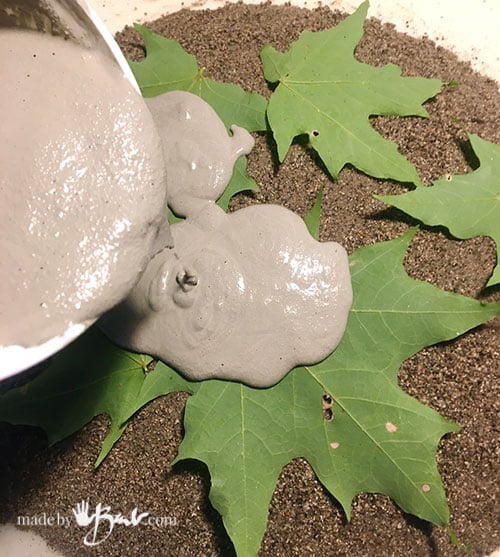
This Sand-Cast Concrete Leaf Plate Project is an easy project since the mound of wet sand creates the shape. See the full tutorial instructions here. I imagine switching up the botanical specimens would yield quite a variety of beautiful castings.
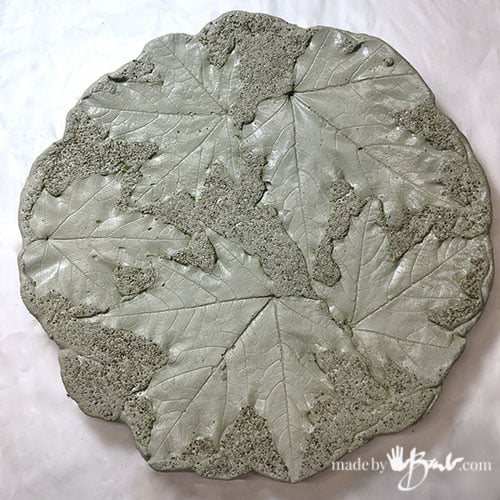
The mounded sand leaves a nice contrast to the exquisite details & smoothness of the leaves. If you add a hanging wire it can become wall art.
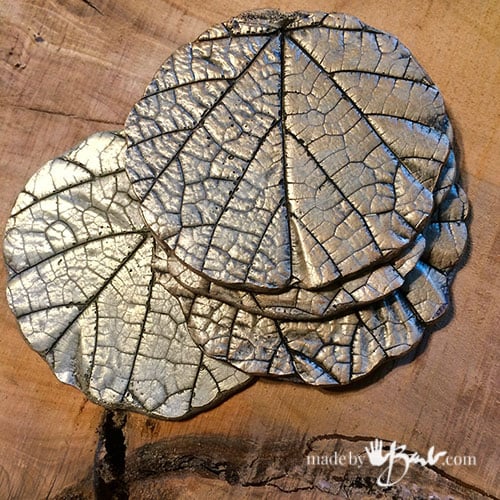
The high strength of Rapidset Cementall makes it great for my very thin DIY Concrete Coasters; such details!
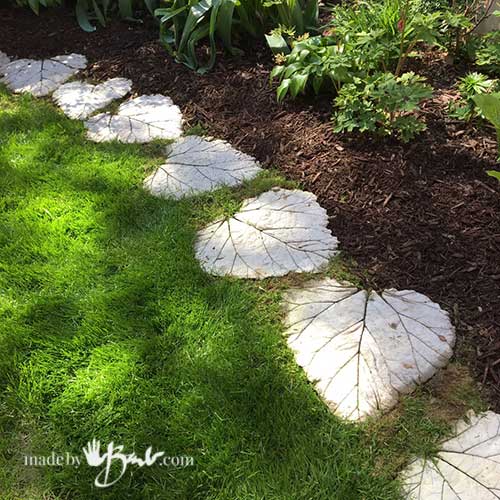
Quikrete SandTopping mix is a longer-setting mix but works well since it also does not have any aggregate in it. It tends to need at least a day to cure enough to remove the leaf. The concrete will need a couple of days (depending on conditions) for a full cure though. It is however not that expensive.
This mix works well for larger items like the Easy Concrete Stepping Stones (that started me on my concrete journey; beginner-friendly project ) and also the Leaf Cast Concrete Bowls. A higher pile of sand can change the form to a bowl instead of a stepping stone.

Depending which size DIY concrete bowl/planter you prefer other leaves like rhubarb can be large enough. As you can see the metallic look paint technique does bring out the amazing details in the leaves. Make sure to pick leaves with great veins & structure. These make great gift ideas and planters for succulents.
Do you need a Mold?
I know that making molds may seem like the answer to making things in multiples. These molds made with silicone and also with latex are some methods for repeat pours. I have even made molds of relief cast plaster (plaster of paris) to then be able to make concrete relief castings. Myself, I’d rather eliminate some the technical issues of building structures & molds if I can use items as an aid to casting the concrete. Using a bowl or box as a form for the leaves & concrete allows easy removal and a lot of customization. The outcomes are much more like an art form than what you see in the stores.
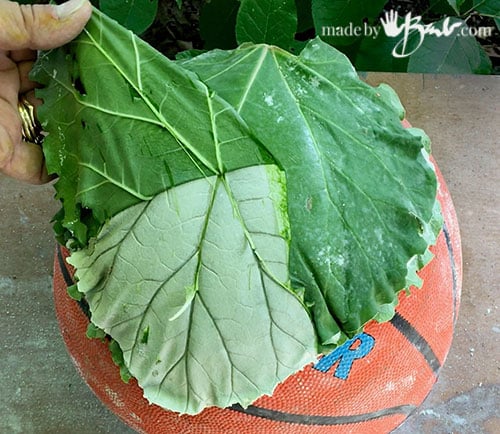
I prefer to make these leaf cast bowls double-sided (using a wide variety of real leaves like rhubarb and hosta) to catch as many details of the leaf. They can be used for bird baths once they have been cured and leached of the extra alkali. Each one will be a one-of-a-kind concrete DIY.

I try to be creative in my use of structures & forms. The simple household items are usually not harmed in the making and can be reused. That makes them perfect for DIY concrete crafts.
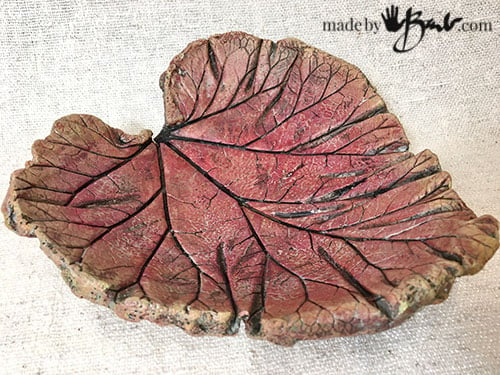
I prefer to keep my concrete finishes natural so that they age over time or show the character of the concrete. You can however use you creative ideas to paint them as you like; even bright colors. ‘Most of the work has already been done in the casting.

There are no rules about how you can use your concrete leaves. I used fabric dipped in Portland cement as a way to create a base form as well. For these leaf bowls I used Burlap with the portland cement give these leaves an interesting surface to mount on.
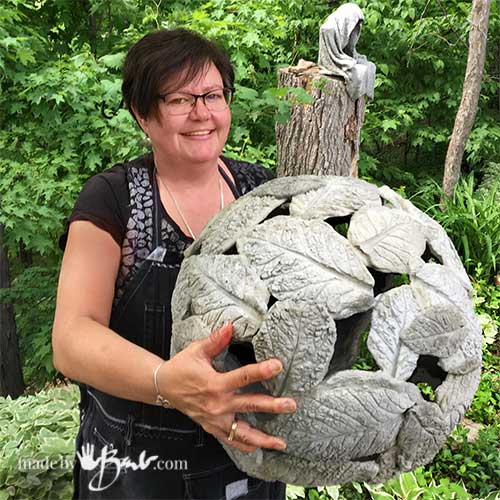
Large or Small forms for Concrete:
Once you feel confident you can explore larger forms. The Gigantic Concretev Leaf Orb is my favourite of all my orbs. With gloves on hands and a nice pasty consistency of a fast-setting concrete mix you can build the outside (with patience) over a removable form. A balloon can work, or other inflatable ball.
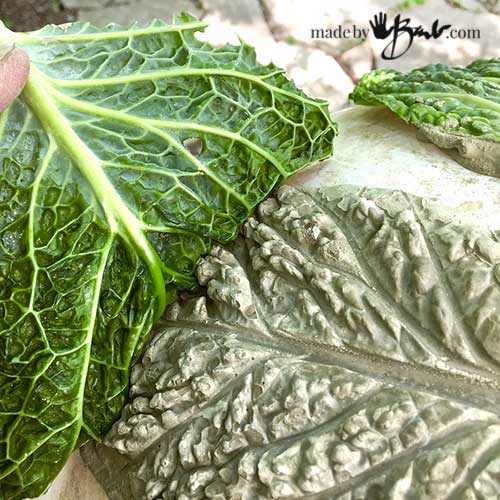
This is a beautiful leaf (cabbage) from the grocery store. The texture of these monster leaves is mind-boggling. The end product can be quite light for the size!

I have even constructed a full size Faux Bois Concrete Chair that drew much inspiration from nature. Look closely, and you will see the leaves there as well!
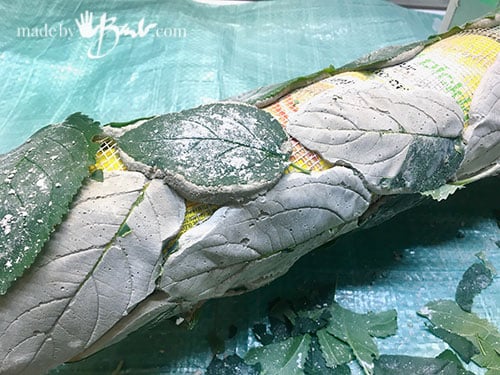
Things that we cast away can become forms as well; like this Leaf-Cast Concrete Lamp

Who knows what is really inside this?! Take the shortcuts where they help you and be creative where you can be…
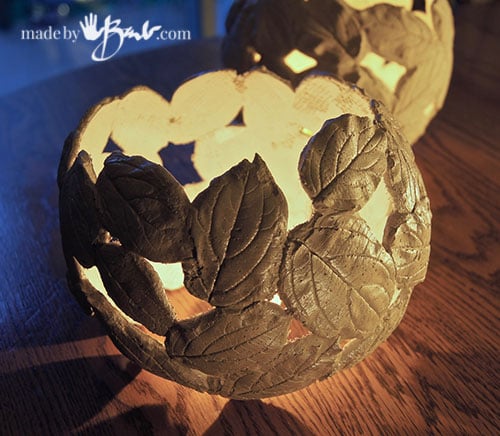
The ability to be quite lacy with the use of the leaves lets you create open-work. This Lacy leaves Concrete Circle allows so much light to shine through.
Do I Need Fancy tools to Create concrete projects with leaves?
Since these are quite simple projects the tools needed are quite simple as well. Be safe when near concrete dust and wear the proper dust mask. Rubber gloves protect your hands from the alkalinity in the concrete as well as keep you cleaner. I usually work in an outdoor space due to the mess.
Most of these projects are using a fast-set concrete so mixing is in small batches. A plastic container/bucket, trowel (or spoon), paint brush, fibre mesh (for reinforcing structure), shovels/scoop and a towel/rag.
This list is only a starting point; I’m sure you can create even more unique sorts of crafts. Many call them cement projects or cement crafts but truly they mean concrete!
I hope I have inspired you for your next DIY project – some beautiful uses of leaves for home decoration…

I admire your works, not only concrete. You are a real artist!
Greetings from “Bayrischer Wald” an area in Germany
Ingrid
Awe, that means a lot to me! (since I am born not far from there!) ❤️🇩🇪
I love the concrete leaf lamp. My driveway could use some designs like that. I’ll have to call a contractor.
Barb, I love the art you create with cement and leaves – especially the garden art with leaf prints.
One project I would love to do is diy cloth napkins, decorated with leaf prints. If you have any ideas how to do this, I’d love to learn.
Marjorie
Funny you should ask… I used leaves to make some silicone Leaf stamps that can be used repeatedly to print on fabric. Enjoy! I may try the version that uses paint directly on leaves soon, but that would mean many more specimens needed…